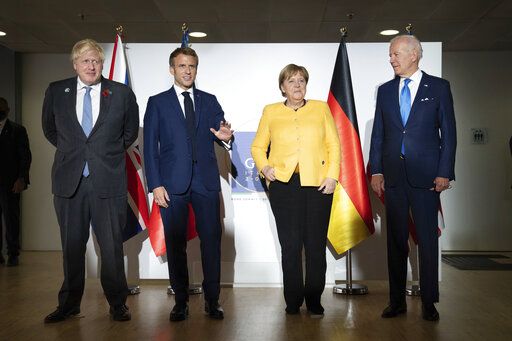EXPLAINER: How G20-backed corporate minimum tax would work
From left, British Prime Minister Boris Johnson, French President Emmanuel Macron, German Chancellor Angela Merkel and U.S. President Joe Biden at the G20 summit in Rome, Saturday, Oct. 30, 2021. The two-day Group of 20 summit is the first in-person gathering of leaders of the world’s biggest economies since the COVID-19 pandemic started. (Stefan Rousseau/Pool via AP)
ROME (AP) — Leaders at the Group of 20 summit in Rome are expressing broad support for sweeping changes in how big global companies are taxed.
The goal: deterring multinationals from stashing profits in countries where they pay little or no taxes — commonly known as tax havens.
The proposal was finalized in October among 136 countries and sent to the G-20 for a final look after complex talks overseen by the Organization for Economic Cooperation and Development. It would update a century’s worth of international taxation rules to cope with changes brought by digitalization and globalization.
The most important feature: a global minimum tax of at least 15%, a key initiative pushed by U.S. President Joe Biden. “This is more than just a tax deal — it’s diplomacy reshaping our global economy and delivering for our people,” Biden tweeted from the summit on Saturday.
Treasury Secretary Janet Yellen says it will end a decadeslong “race to the bottom” that has seen corporate tax rates fall as tax havens sought to attract businesses that used clever accounting to take advantage of low rates in countries where they had little real activity.
Here’s a look at key aspects of the tax deal:
___
WHAT WAS THE PROBLEM?
In today’s economy, multinationals can earn big profits from things like trademarks and intellectual property that are easier than factories to move. Companies can assign the earnings they generate to a subsidiary in a country where tax rates are very low.
Some countries compete for revenue by using rock-bottom rates to lure companies, attracting huge tax bases that generate large revenue even with tax rates only marginally above zero. Between 1985 and 2018, the global average corporate headline rate fell from 49% to 24%. By 2016, over half of all U.S. corporate profits were booked in seven tax havens: Bermuda, the Cayman Islands, Ireland, Luxembourg, the Netherlands, Singapore and Switzerland. White House officials are saying the global minimum would result in almost $60 billion of added U.S. tax revenue.
___
HOW WOULD A GLOBAL MINIMUM TAX WORK?
The basic idea is simple: Countries would legislate a minimum rate of at least 15% for very big companies with annual revenues over 750 million euros ($864 million)
If company earnings go untaxed or lightly taxed in one of the world’s tax havens, their home country would impose a top-up tax that would bring the rate to 15%.
That would make it pointless for a company to use tax havens, since taxes avoided in the haven would be collected at home.
___
HOW WOULD THE TAX PLAN ADDRESS THE DIGITALIZED ECONOMY?
The plan would also let countries tax part of the earnings of the 100 or so biggest multinationals when they do business in places where they have no physical presence, such as through internet retailing or advertising. The tax would only apply to a portion of profits above a profit margin of 10%.
In return, other countries would abolish their unilateral digital services taxes on U.S. tech giants such as Google, Facebook and Amazon. That would head off trade conflicts with Washington, which argues such taxes unfairly target U.S. companies.
___
WHAT IS THE U.S. ROLE IN THE AGREEMENT?
Biden has staked a claim that the U.S. must join the global minimum tax in order to persuade other nations to do so. That would involve raising the current rate for foreign earnings from 10.5% to reflect the global minimum. His tax proposals are still being negotiated in Congress.
U.S. participation in the minimum tax deal is crucial, simply because so many multinationals are headquartered there — 28% of the 2,000 biggest global companies. Complete rejection of Biden’s global minimum proposal would seriously undermine the international deal.
___
DOES EVERYONE LIKE THE DEAL?
Some developing countries and advocacy groups such as Oxfam and the UK-based Tax Justice Network say the 15% rate is too low. And although the global minimum would capture some $150 billion in new revenue for governments, most of it would go to rich countries because they are where many of the biggest multinationals are headquartered. Developing countries took part in the talks and all signed except for Nigeria, Kenya, Pakistan and Sri Lanka.
U.S. critics including Republican leaders and some business groups say the proposed minimum tax would make America less competitive and potentially cost jobs, a sign that the key is to get passage from other nations so the U.S. is not disadvantaged.
___
ANY OTHER CAVEATS?
The EU Tax Observatory research consortium cautions that exemptions for companies with actual assets and employees in a given country could “exacerbate tax competition by giving firms incentives to move real activity to tax havens.”
That means some tax competition among countries would still be possible when actual business operations — as opposed to shifty accounting — are involved.
___
HOW WOULD THE AGREEMENT TAKE EFFECT?
Backing from the G-20 leaders completes a yearslong process of negotiation. Once approval is reflected in the summit’s final statement, expected Sunday, implementation then moves to the individual nations.
The tax on earnings where companies have no physical presence would require countries to sign on to an intergovernmental agreement in 2022, with implementation in 2023. The global minimum could be applied by individual countries using model rules developed by the OECD. If the U.S. and European countries where most multinationals are headquartered legislate such minimums, that would have much of the intended effect, even if some tax havens don’t.
___
Associated Press writer Joshua Boak in Washington contributed to this report.
Copyright 2021 The Associated Press. All rights reserved.


